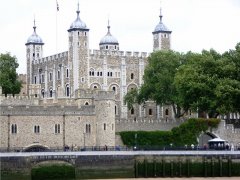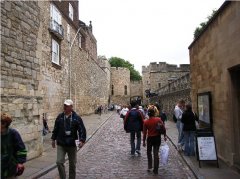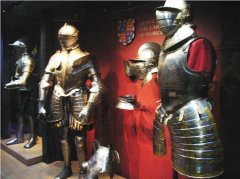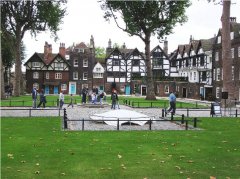United Kingdom historical sites
 The Palace of Westminster is perhaps better known as the Houses of Parliament and the meeting place of the House of Commons and the House of Lords, the two houses of Parliament of the United Kingdom.
The Palace of Westminster is perhaps better known as the Houses of Parliament and the meeting place of the House of Commons and the House of Lords, the two houses of Parliament of the United Kingdom.
The history of the site started in Roman times when a temple dedicated to Apollo is believed to have stood on the site. Although its present development began in the 8th century when a Saxon church dedicated to St Peter was constructed and became known as the West Minster. In the 10th century it became part of a Benedictine abbey and was used as the Royal church, it was its association with the Kings that resulted in the expansion of the site, something that was started by King Cnut (1016 1035).
The sites development over the centuries resulted in two palaces, the Old Palace, which was a medieval building constructed in the 11th century and the New Palace constructed after the Old Palace was destroyed by fire.
The Old Palace became the primary residence of the Kings of England from 1049 with Edward the Confessor (1042 1066) until 1532 when Henry VIII (1509 1547) acquired York Place from Cardinal Thomas Wolsey and converted it to become the Palace of Whitehall. The Royal Council, the predecessor of Parliament, met in Westminster Hall from the 11th century. From 1295 it was the venue of the Model Parliament, the first official Parliament of England. This consisted of clergy, aristocrats and representatives of the counties and boroughs of the Kingdom. It was also the venue for the various Royal Courts of Justice. The commons were given permanent use of St Stephens Chapel (now St Stephens Hall) in 1547 having previously used various parts of the palace or Westminster Abbey for their meetings.
 The Palace underwent a number of alterations from the 18th century onwards, as more buildings were added including a new west façade between 1755 and 1770 in order to provide more document storage and committee rooms.
The Palace underwent a number of alterations from the 18th century onwards, as more buildings were added including a new west façade between 1755 and 1770 in order to provide more document storage and committee rooms.
On 16 October 1834, a fire broke out in the Palace due to an overheated furnace which set fire to the House of Lords Chamber. This then spread to the Commons Chamber and most of the other parts of the complex, with the exception of Westminster Hall, the Cloisters of St Stephen, the Jewel Tower and the Chapel of St Mary. King William IV (1830 1837) offered Buckingham Palace as an alternative though this was deemed to be unsuitable and was therefore declined.
In 1836, 97 design proposals for the new palace had been submitted for consideration and the Gothic style design by Charles Barry was accepted. In 1840 work started and the Lords Chamber was completed in 1847, the Commons Chamber in 1852 and most of the other buildings by 1860; although it took over 30 years to finish the work completely, delays occurring due to cost increases and by the death of Barry in 1860.
 Built on the neo-classical principle of symmetry it contains over 1, 100 rooms, 100 staircases and 3 miles (4.8 kilometres) of passageways, spread over four floors. Its façade stretches for 266 metres along the bank of the River Thames. Although mainly completed by 1870 work on the interior decoration continued intermittently well into the twentieth century.
Built on the neo-classical principle of symmetry it contains over 1, 100 rooms, 100 staircases and 3 miles (4.8 kilometres) of passageways, spread over four floors. Its façade stretches for 266 metres along the bank of the River Thames. Although mainly completed by 1870 work on the interior decoration continued intermittently well into the twentieth century.
During the Second World War the Palace was hit by bombs on fourteen separate occasions. One bomb fell into Old Palace Yard and severely damaged the south wall of St Stephen's Porch and the west front. The statue of Richard I (1189 1199) the Lionheart, was blown from its pedestal, another bomb destroyed much of the Cloisters. The Clock Tower was also hit blowing out all the glass on the south dial although the hands and bells were not affected and the Clock continued to keep time. The worst incident however, was on the night of 10/11 May 1941, when the Palace took twelve hits killing three people. An incendiary bomb hit the chamber of the House of Commons setting it on fire; while another caused the roof of Westminster Hall to catch fire causing significant damage.
In 1975 the Palace space has extended to allow MPs to have their own office when it acquired the Norman Shaw Building and in 2000 the custom-built Portcullis House was completed. Portcullis House is accessed by a secure tunnel running from the Palace under Bridge Street. The building contains a glazed covered courtyard with a cafeteria with meeting rooms on the first floor and offices above.
A visit to the Palace will normally follow a prescribed route which includes the main rooms. Unfortunately photographs are not permitted other than in Westminster Hall so none of the other rooms are shown in the video below although the official site of the Palace of Westminster does include some excellent photos and virtual tours. Passing through security visitors enter Westminster Hall which was constructed in 1097 and is the oldest existing part of the Palace of Westminster, which at the time of construction was the largest hall in Europe. The roof was originally supported by pillars, but this was changed during the reign of Richard II (1377 1399) to the hammerbeam roof which looks like an inverted ships keel.
Westminster Hall has served numerous functions including housing the main judicial courts of the land. It has also housed a number of important trials, including that of King Charles I (1625 1649), Sir William Wallace, Guy Fawkes and Sir Thomas More whose commemorative plaque can be found on the floor of the hall, along with some of the famous who lay in state after their death.











